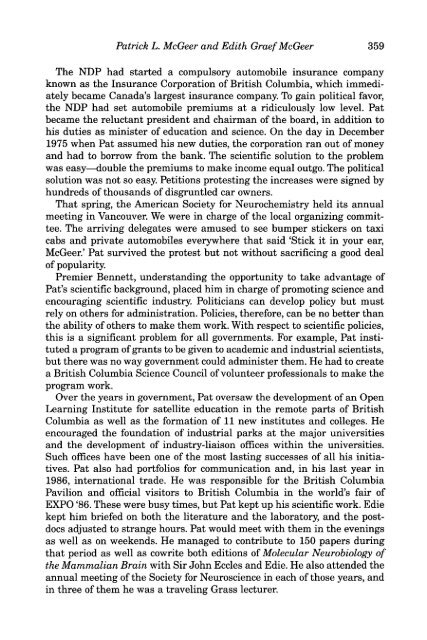Edith Graef McGeer - Society for Neuroscience
Edith Graef McGeer - Society for Neuroscience
Edith Graef McGeer - Society for Neuroscience
Create successful ePaper yourself
Turn your PDF publications into a flip-book with our unique Google optimized e-Paper software.
Patrick L. <strong>McGeer</strong> and <strong>Edith</strong> <strong>Graef</strong><strong>McGeer</strong> 359<br />
The NDP had started a compulsory automobile insurance company<br />
known as the Insurance Corporation of British Columbia, which immediately<br />
became Canada's largest insurance company. To gain political favor,<br />
the NDP had set automobile premiums at a ridiculously low level. Pat<br />
became the reluctant president and chairman of the board, in addition to<br />
his duties as minister of education and science. On the day in December<br />
1975 when Pat assumed his new duties, the corporation ran out of money<br />
and had to borrow from the bank. The scientific solution to the problem<br />
was easy—double the premiums to make income equal outgo. The political<br />
solution was not so easy. Petitions protesting the increases were signed by<br />
hundreds of thousands of disgruntled car owners.<br />
That spring, the American <strong>Society</strong> <strong>for</strong> Neurochemistry held its annual<br />
meeting in Vancouver. We were in charge of the local organizing committee.<br />
The arriving delegates were amused to see bumper stickers on taxi<br />
cabs and private automobiles everywhere that said 'Stick it in your ear,<br />
<strong>McGeer</strong>.' Pat survived the protest but not without sacrificing a good deal<br />
of popularity.<br />
Premier Bennett, understanding the opportunity to take advantage of<br />
Pat's scientific background, placed him in charge of promoting science and<br />
encouraging scientific industry. Politicians can develop policy but must<br />
rely on others <strong>for</strong> administration. Policies, there<strong>for</strong>e, can be no better than<br />
the ability of others to make them work. With respect to scientific policies,<br />
this is a significant problem <strong>for</strong> all governments. For example, Pat instituted<br />
a program of grants to be given to academic and industrial scientists,<br />
but there was no way government could administer them. He had to create<br />
a British Columbia Science Council of volunteer professionals to make the<br />
program work.<br />
Over the years in government, Pat oversaw the development of an Open<br />
Learning Institute <strong>for</strong> satellite education in the remote parts of British<br />
Columbia as well as the <strong>for</strong>mation of 11 new institutes and colleges. He<br />
encouraged the foundation of industrial parks at the major universities<br />
and the development of industry-liaison offices within the universities.<br />
Such offices have been one of the most lasting successes of all his initiatives.<br />
Pat also had portfolios <strong>for</strong> communication and, in his last year in<br />
1986, international trade. He was responsible <strong>for</strong> the British Columbia<br />
Pavilion and official visitors to British Columbia in the world's fair of<br />
EXPO '86. These were busy times, but Pat kept up his scientific work. Edie<br />
kept him briefed on both the literature and the laboratory, and the postdocs<br />
adjusted to strange hours. Pat would meet with them in the evenings<br />
as well as on weekends. He managed to contribute to 150 papers during<br />
that period as well as cowrite both editions of Molecular Neurobiology of<br />
the Mammalian Brain with Sir John Eccles and Edie. He also attended the<br />
annual meeting of the <strong>Society</strong> <strong>for</strong> <strong>Neuroscience</strong> in each of those years, and<br />
in three of them he was a traveling Grass lecturer.











![[Authors]. [Abstract Title]. - Society for Neuroscience](https://img.yumpu.com/8550710/1/190x245/authors-abstract-title-society-for-neuroscience.jpg?quality=85)





